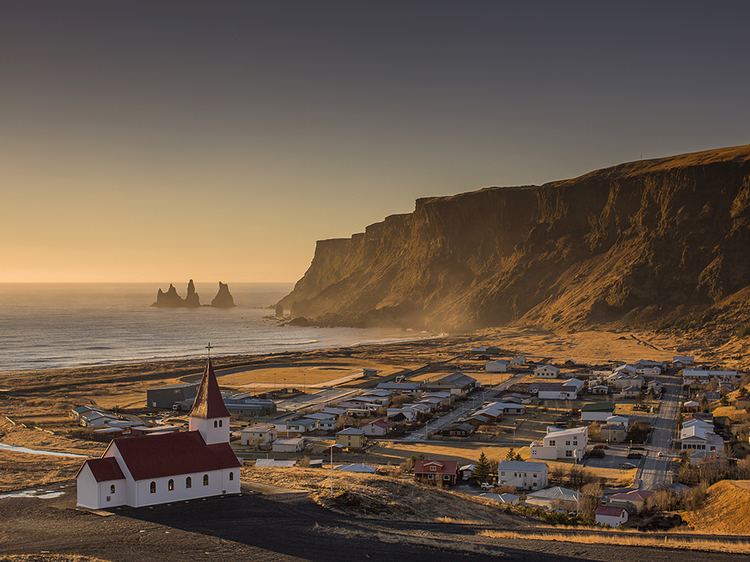Population 318 (2016) | Constituency South Constituency Time zone GMT (UTC+0) Local time Wednesday 2:46 PM | |
 | ||
Weather 2°C, Wind NE at 23 km/h, 87% Humidity | ||
V k m rdal iceland the village of vik hd
The village of Vík ([ˈviːk]; or Vík í Mýrdal in full) is the southernmost village in Iceland, located on the main ring road around the island, around 180 km (110 mi) by road southeast of Reykjavík.
Contents
- V k m rdal iceland the village of vik hd
- Map of Vik Iceland
- Overview
- Danger from Katla
- Climate
- References
Map of Vik, Iceland
Despite its small size (291 inhabitants as of January 2011) it is the largest settlement for some 70 km (43 mi) around and is an important staging post, thus it is indicated on road signs from a long distance away. It is an important service center for the inhabitants of and visitors to the coastal strip between Skógar and the west edge of the Mýrdalssandur glacial outwash plain.
Overview
In 1991, the US journal Islands Magazine counted this beach as one of the ten most beautiful beaches on Earth. Its stretch of black basalt sand is one of the wettest places in Iceland. The cliffs west of the beach are home to many seabirds, most notably puffins which burrow into the shallow soils during the nesting season. Offshore lie stacks of basalt rock, remnants of a once more extensive cliffline Reynisfjall, now battered by the sea. There is no landmass between here and Antarctica and the Atlantic rollers can attack with full force. According to folklore, they are former trolls who tried to drag their boats out to sea only to be caught by the rising dawn. The sea around them is rather wild and stormy, so travelers will not be surprised to discover a monument to the memory of drowned seamen on the beach.
Contemporary legends note the story of a husband who found his wife taken by the two trolls, frozen at night. The husband made the two trolls swear to never kill anyone ever again. His wife was the love of his life, whose free spirit he was unable to provide a home for; she found her fate out among the trolls, rocks, and sea at Reynisfjara.
The village was affected by volcanic ash during the 2010 eruptions of Eyjafjallajökull.
Danger from Katla
Vík lies directly south of the Mýrdalsjökull glacier, which itself is on top of the Katla volcano. Katla has not erupted since 1918, and this longer than typical dormant period has led to speculation that an eruption may occur soon. An eruption of Katla could melt enough ice to trigger an enormous flash flood, potentially large enough to obliterate the entire town. The town's church, located high on a hill, is believed to be the only building that would survive such a flood. Thus, the people of Vík practice periodic drills and are trained to rush to the church at the first sign of an eruption.
Climate
Vík í Mýrdal is the warmest place in Iceland with an annual mean temperature of 5.3 °C (41.5 °F). Like most of coastal Iceland, Vík í Mýrdal has a subpolar oceanic climate (Koppen: Cfc) with cold but not severe winters and cool, short summers. Its winters are among the warmest in Iceland, with an average winter day having a daytime high around 4 °C (39 °F). Because it lies on the windward side of the Gulf Stream, Vík í Mýrdal is the wettest coastal town in Iceland, with an annual rainfall of 2,250 millimetres (89 in), which is three times more than Reykjavík, five times more than Akureyri on the north coast of the island and many times more than its far northernly location would normally indicate. Precipitation on the Mýrdalsjökull and Vatnajökull glaciers near the town is believed to be as high as 160 inches (4,100 mm) of rainfall equivalent, which would mean at least 160 feet (49 m) of snow at those higher altitudes.
